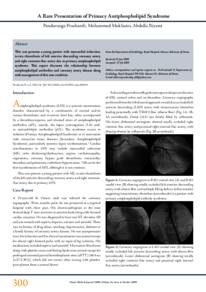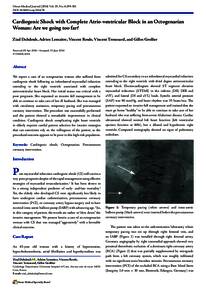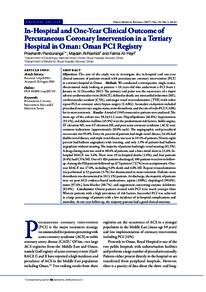وثيقة
Immediate and six-month clinical outcome of percutaneous coronary intervention in a tertiary hospital in the Sultanate of Oman.
المساهمون
Al-Mukhani, Mohammad., مؤلف
Al-Riyami, Abdullah., مؤلف
Sulaiman, Kadhim., مؤلف
Shahrabani, Rashid., مؤلف
الناشر
Oman Medical Specialty Board.
ميلادي
2008-10
اللغة
الأنجليزية
الموضوع
الملخص الإنجليزي
Objective: To evaluate the clinical characteristics, angiographic
profile, in-hospital and six-month clinical outcome of patients
who underwent percutaneous coronary intervention in a tertiary
hospital in the Sultanate of Oman.
Methods: Two hundred and five consecutive patients with both
acute coronary syndrome and stable coronary artery disease, who
underwent percutaneous coronary intervention between January
2007 and June 2007, were retrospectively analyzed. Follow-up
information was obtained from outpatient visits of these patients
at six-months.
Main outcome measures: The primary end point in this study was
the occurrence of major adverse cardiovascular events (MACE),
defined as cardiac death, any myocardial infarction (MI),
cerebrovascular accident (CVA) and target vessel revascularization
(TVR) with either repeat percutaneous coronary intervention
(PCI) or coronary artery bypass surgery (CABG). Secondary end
points included angiographic success rate, procedural success rate,
angina status, and the rate of clinical and angiographic restenosis.
Results: The angiographic and procedural success rate was 98%
and 95% respectively. Fifty-one percent of patients surveyed had
single vessel disease, 34% had double vessel disease and triple
vessel disease was seen in 15% of patients. Type A lesion was
found in 16%, Type B in 55% and Type C in 29% of patients. The
majority of patients had single vessel stenting (83%). The mean
± SD number of stents per patient was 1.6 ± 0.9.There were
four in-hospital deaths (2%) and six patients (2.9%) had non-ST
elevation myocardial infarction before hospital discharge. Out
of 205 patients, 53 patients were lost to follow-up. Among the
148 patients followed up, 105 patients (71%) were asymptomatic
at follow-up, 36 (24%) patients had stable angina and 7 (5%)
had a late myocardial infarction including three patients with
stent thrombosis (2%). Among the 43 patients with angina or
late infarction, 28 patients underwent coronary angiogram.
Angiographic in-stent restenosis was seen in 14 patients. Of
them, 8 patients underwent CABG and 6 patients repeat PCI.
Fourteen patients had patent stents.The remaining fifteen patients
were on optimal medications including two patients with stent
thrombosis as they refused coronary angiogram. Overall, 132 of
148 patients (105 asymptomatic/14 patent stents/13 with angina)
(89%) were free from major adverse cardiac events. Considering
anginal status and repeat angiograms, composite clinical (15
patients) and angiographic (14 patients) six-month restenosis
rate in percutaneous coronary intervention patients (29/148) was
19.5%.
Conclusion: Results of percutaneous coronary intervention in our
setup is excellent with good immediate results, low complication
rate, good six-month clinical outcome and is comparable to
international standards.
المجموعة
URL المصدر
zcustom_txt_2
Prashanth, Panduranga, Al-Mukhani, Mohamm, Al-Riyami, Abdullah, Sulaiman, Kadhim,Shahrabani, Rashid, & Al-Riyami, Abdullah M. (2008). Immediate and six-month clinical outcome of percutaneous coronary intervention in a tertiary hospital in the Sultanate of
قالب العنصر
مقالات الدوريات




